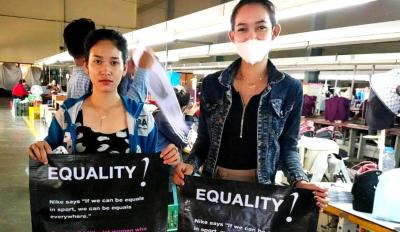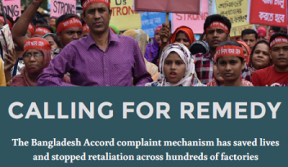
Today, in recognition of International Women’s Day, many of the biggest global brands are splashing their commitment to women’s equality across their social media and advertising but, if we want to know what they really think about equality, we should look at their supply chains.
While it seems that International Women’s Day has now been reduced to memes and discounts on robot vacuums, the origins of International Women’s Day come from women workers organizing for better jobs. On March 8, 1857 women garment workers in NYC went on strike, protesting unfair working conditions and demanding equal rights. Over 50 years later in the early 1900s, more women textile workers began marching on the anniversary in the U.S. and the movement spread around the world.
These demands still resonate today, but corporate giants tend to ignore them when it comes to the conditions millions of women workers in their global supply chains face on the job.
Virtually every global industry now uses a subcontracting model, which enables big-name brands to rely on a network of contractors and subcontractors to manufacture, transport and even sell their goods, putting a great deal of distance between the globally-recognized brand and the workers who produce their products. That makes it easier for companies to shirk their responsibilities to those workers, especially those who try to organize. Suppliers crack down because they know a unionized workforce that has rights on the job and the ability to demand and win fair pay at the bargaining table is a more expensive workforce. Billionaire brands hold all the leverage and will quickly move on to new suppliers who have a cheaper workforce, even while publicly proclaiming their commitments to “ethically made” products,a “sustainable supply chain” and a commitment to women’s empowerment.
In the garment industry in particular, we can see how many of the same injustices remain as they were in the 1850s. The factories may have moved and technology has changed, but the women workers continue to get squeezed in the name of profit.
That’s certainly true for thousands of mostly women garment workers and their unions in six countries in Southeast Asia who are demanding Nike, VF Corporation and Levi Strauss & Co., repay millions of dollars in stolen pandemic wages they have been owed for almost four years.
Women who work in factories making Nike clothes say that when factories closed in the spring of 2020 they faced dire circumstances, struggling to feed their families and in some cases racking up huge debts that they are still trying to pay off. Meanwhile Nike rebounded and authorized $18 billion in buybacks as it came out of the pandemic.
The workers in the factories are calling on the company to make good on its claims to support women and sit down with their unions to create a joint strategy for ensuring garment workers in Nike’s supply chain work under decent conditions and are paid living wages.
But if last year is any guide, Nike is likely to make a nod to women’s equality today by splashing some feel-good language on its social media platforms and perhaps offering a discount code.
To truly respect and empower women, brands must first do so in their own supply chain by supporting and enabling all workers to form their own independent unions. When workers are able to do so, the results are transformative.
Almost two years ago, major clothing brands, and a supplier in Tamil Nadu, India, signed the Dindigul Agreement to End Gender-Based Violence and Harassment, a set of interlocking agreements with the Tamil Nadu Textile and Common Labour Union, the Asia Floor Wage Alliance and my organization Global Labor Justice-International Labor Rights Forum to signify a joint commitment to eliminating caste and gender-based violence and harassment (GBVH) at the factory complex. As part of the agreement, the union was recognized as the representative of the workers and as a facilitator and trainer in the process to eliminate GBVH.
The results of that agreement are clear as the majority migrant Dalit female workforce reported major positive changes in their workplace just months later. Today, workers say that they have a much safer workplace and that while cases of harassment still come up, they are empowered to address them directly with the support of their union. The union has also been able to address other issues with management and overall working conditions have improved.
While this is one small example in a huge global sector, it does show the way forward for all global brands who truly want to support women.
It is only when women workers– and all workers– can come together in independent unions that they have a real chance to fight back and win equality. Rather than some feel-good posts, that is what these big brands should be focused on today and every day.

